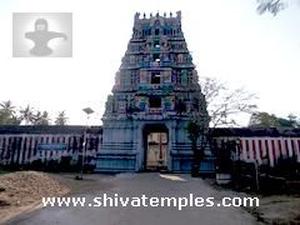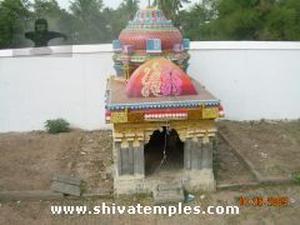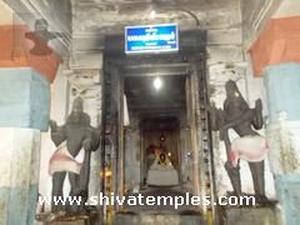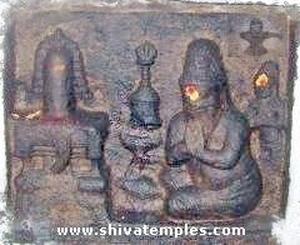Pasupatheeswarar Temple, Avoor Pasupatheeswaram
Location: Avoor Pasupatheeswaram
Deity known as: Pasupatheeswarar
Female Deity: Mangalaambikai, Pankajavalli
Pathikam: TiruGyānasambandhar - 1
Gallery - Pasupatheeswarar Temple
 5 Tiered Tower
5 Tiered Tower
 Saptha Matha
Saptha Matha
 Sannidhi of Muruga
Sannidhi of Muruga



How to reach
This shiva temple is located 12 Kms to the south-west of Kumbakonam, on the Kumbakonam-Melattur-Thanjavur road.
Temple Address
Avoor
Avoor post
Valangaiman Taluk
Tiruvarur District
PIN - 612701.
Temple hours
Morning: 6:00 - 11:00
Evening: 4:00 - 8:30
Near by Temples
| 1 | Tiru-Chakkara-Palli - 18.7 kms | |
| 2 | Tiru-karukavur - 8.2 kms | |
| 3 | TiruPālaithurai - 10 kms | |
| 4 | Tiru-Nallur - 8 kms | |
| 5 | Tiru-Shakthi-Mutham - 4.4 kms |
Temple History
Long ago, a contest of strength arose between Adisesha, the celestial serpent, and Vayu, the lord of winds. Adisesha, with his thousand mighty hoods, wound himself tightly around Mount Kailash, holding it fast in his embrace. Vayu, assuming the form of a tempest, unleashed his furious gales to shake the immovable mountain. The heavens trembled, and the gods, struck with fear, prayed for peace. At their plea, Adisesha eased his grip ever so slightly. In that very moment, Vayu seized the chance, tore away two peaks of Kailash, and carried them southward. One he placed at Avoor and the other at nearby Tiru-Nallur.
Kamadhenu, the celestial cow, was once afflicted by a curse from the sage Vashishta. Following the counsel of Brahma, she came to this sacred site and worshipped the presiding deity, thereby being freed from the curse. As the Deity was worshipped by the cow — ‘Ā’ (the long “A” sound, as in father) in Tamil — the place came to be known as Avoor. The spot where Kamadhenu first descended from the heavens is located nearby and is known as Govindakudi. Even today, on the kodimaram (flagstaff), one can see a sculpted image of a cow pouring its milk in reverence over a Shivalinga.
Temple Architecture
Mādakovil
Avoor Pasupatheeswarar Temple is one of the famed Maadakovils built by the Chola king Kochengat Chola. The temple welcomes visitors with a majestic, east-facing, five-tiered Raja Gopuram. Upon entering through the gateway, one’s attention is immediately drawn to the Kodimaram (flagstaff), Balipeetam (sacrificial altar), and Nandi Mandap, all located in the eastern outer prakaram. The sanctum of the presiding deity is set on an elevated platform, accessible by a flight of steps from the southern outer prakaram. These steps lead to the Maha Mandap, followed by the Artha Mandap, and finally the sanctum housing Pasupatheeswarar. The deity, a self-manifested Swayambhu Linga, faces east, radiating a profound spiritual presence.
Mangalambikai and Pankajavalli
In the Maha Mandap, there are two south-facing sannidhis dedicated to the divine consorts Mangalambikai and Pankajavalli. Mangalambikai, who was discovered in a pond, was consecrated here and is worshipped with great reverence. Goddess Pankajavalli is of ancient origin, her presence attested by the verses of Tirugnanasambandar, who praised her in his pathigam. While both deities are venerated, Mangalambikai is especially revered and considered more auspicious, drawing the heartfelt devotion of countless worshippers.
Other Deities
King Dasaratha is believed to have worshipped the presiding deity of this temple. A sculpted image in the inner prakaram beautifully depicts Dasaratha offering his devotion to a Shiva Linga. The inner prakaram also houses the sacred forms of the Saptha Matrikas, as well as a sannidhi dedicated to the Navagrahas. The temple’s Muruga is especially unique, holding a bow and arrow in his hands. He is worshipped along with his consorts Valli and Deivanai, in an east-facing sanctum located in the western outer prakaram.
Sacred Tree
The Peepal tree is revered as the 'sthala vruksham' of this temple, while the Brahma Theertham and Kamadhenu Theertham are its holy waters. Among devotees, the Kamadhenu Theertham is affectionately called 'Dhenu' Theertham. Pasupatheeswar has been revered and worshipped by Brahma, the Saptarishis, the celestial Devas, Indra, the Sun God, the Navagrahas, and the great sage Vashishta.
Pancha Bhairava
This temple is revered as 'Pancha Bhairava' temple. In the Maha Mandap, devotees can have darshan of four west-facing Bhairava forms and one north-facing Bhairava, self-manifested in their divine forms. Worship of Bhairava here is considered highly auspicious and is believed to grant powerful protection. On the Ashtami tithi, lighting lamps with sesame oil and offering prayers is said to remove afflictions caused by malevolent forces, curses, and other harmful influences. It is believed to dispel the fear of death, protect against vehicle accidents, and bring relief from family conflicts. Disputes between couples are resolved, fostering harmony and unity within the household. These Bhairava forms are known as Asithanga Bhairava, Guru Bhairava, Chanda Bhairava, Kala Bhairava, and Unmatha Bhairava, each representing a unique aspect of divine power, protection, and grace.
Tiru-Gyanasambandhar pathigam
The hymns composed by Tirugyanasambandar in praise of the presiding deity Pasupatheeswarar are included in the First Thirumurai, making this temple a cherished site of devotion and spiritual significance.
Gallery






